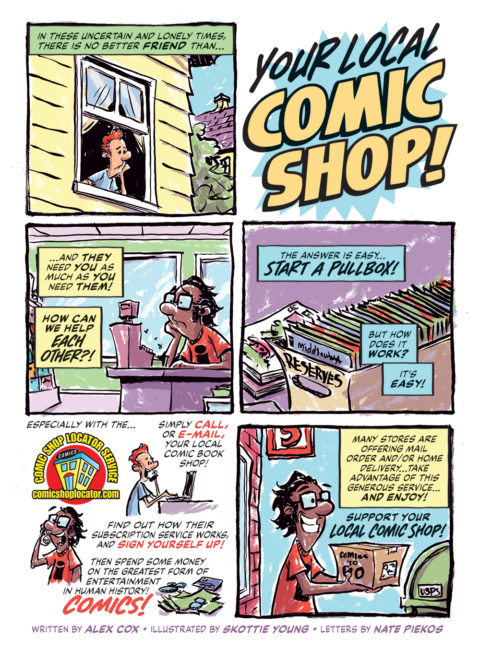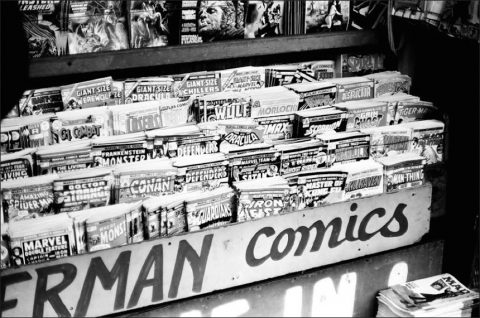I was speaking with someone the other day about comics. They’ve been a comic reader for a few years and was upset because they couldn’t make it into their local comic shop on Wednesday to get their new comics.
I asked if they have a pull list. No idea what that was. I then suggested they could call and get their new books put aside for them, to which they replied that they don’t know what comics they are coming out. This led me to ask about the Diamond Previews catalogue, which also went nowhere.
Suddenly all my comic shop experience collided with the rest of the retail world, and I realized just how broken the current comics retail market is.
This was a regular consumer of moderate means who enjoys comics as one of their modes of entertainment. They’ve evolved beyond the casual buyer to a regular Wednesday (new comics day) buyer, going to a local comic shop and taking advantage of the immediate gratification of seeing something new and leaving the shop with it. See it, buy it, enjoy it. Like the rest of the first world consumerist society we live in.
That’s exactly how your shopping experience at a local comic shop should be, but the comics industry isn’t built like that.
Let’s take a look at a few of the factors that stymie the process.
First off, the comic shop itself. They have to buy the product from the distributor a few months in advance, often with little detail. So they will order what they think they can sell, and will take fewer chances on new and therefore unproven material. Every new title is a risk, and every unsold copy is eating their profit. With thousands of comics available each month, they can’t afford to stock everything.
To offset this unknown sales quantity the local comic shop most likely offers a pull service. The customer provides a list of titles they want and the local comic shop pulls those comics and puts them aside. This allows the retailer to get an idea of how many comics are needed based on preorders. The pull list sounds like a good idea, but it places two burdens on the customer: coming in regularly to pick up their preordered comics and knowing what comics they want before they’re published.
The first customer burden is the most dire to the retailer. Until the comics are picked up they are unsold inventory. And it’s a common occurrence for customers to put back or not want to buy a comics once it’s in their hand, since they preordered it sight unseen with little to no detail. Or even worse stop going to the local comic shop and let their preordered comics pile up, moving on with no notice or thought given.
On to that second customer burden: knowing what to preorder. A little background: there is one comics distributor, Diamond Comics. They’re the only distributor for the monthly 30 or so page pamphlet colloquially referred to as a comic book. Diamond publishes a catalogue the forth week of every month called Previews and charges $3.99 for it. It lists what will be published in two months: the June 2019 catalogue is for comics released in August 2019.
Give this a minute to sink in. Consumers are given the same information as the retailer, both of whom must buy a catalogue to determine what to preorder. With a two month window. Many retailers will give a copy of Previews to their pull list subscribers, or offer it at a discount. Because getting the advantage of knowing what and how many to order offsets that expense.
Yes, preorders are used by all variety of retailers, from sneakers to Blu-Rays. But I can’t think of another industry that is so reliant on the process. If you follow comic creators on social media you will frequently see them asking their fans to preorder their comics to guarantee the comic gets published. It’s this tight two month cycle of solicit, order, publish that leaves so little room.
So where does that leave the comic reader spoken of earlier? Should they be concerned with any of this? In a perfect world, no. And they probably will never need to concern themselves with it, as long as they faithfully appear every Wednesday and buy from the limited number of comics available on the retailer’s shelves. But miss a week…
Next time we’ll look at how the industry got to this place, what’s changing to combat it and whether the rest of the comics world has it right and North America is all wrong.




A very good summary of what is going on in the marketplace but there is so much more that could be talked about. For example, retailers with pull lists could not allow returns of pre-ordered comics. They could also have an on-file credit card number that is charged as soon as the book goes into the pull bin. Usually pull list customers receive a discount and this could be discontinued or reduced and each pull customer given a copy of the Diamond catalogue. However, this does not address the issue of the casual customer. Here we see where the publishers are killing the market place. There have always been multiple titles for popular characters. However it was fairly easy to follow for even the casual reader. Now I look at the comic shelves and if I want to read an Avengers story I have no idea where I would start: what title, what issue, is it a cross-over?? When will the story come to a conclusion? Is there anywhere to pick up a good story in just one issue? X-men and Batman are also especially bad when it comes to this for the casual reader. What if you want to read a limited issue story……say…….by Archie? Often comic shops will order in the first issue or two and then forget about the rest. Even worse, Archie will not finish the story line. Can anyone say Afterlife with Archie? Or their Dark Circle line that had such promise. It seems to have basically fallen off the face of the earth.
I understand that publishing and distributing and selling comics are businesses. But the marketplace control exercised by Diamond is ridiculous and should probably be looked at by whatever government agencies deal with monopolies. The methods of selling at retail haven’t changed since the early 1980s. And the publishers seem to be content with no strategy except throwing more product into the marketplace and seeing what sticks; with no respect for the fans (customers) of their products. There is no doubt that this is being heavily influenced by the need for product and recognition in the TV and movie marketplace too. Cause that’s where the real money is. There is probably a great PhD thesis ready to be written on the intersection of rampant capitalism and pathological interest in characters and stories that for the most part repeat the same story over and over. In the meantime, the casual fan and the small retailer are getting screwed. I think I’m starting to ramble.
Well, Scott and Robin, where can I start this? I co-owned a chain of retail stories, Comics and Comix, from 1972 to 1988, and I was a books and fanzines distributor from before the Direct Market got started, and a new comics distributor until I sold out to Diamond Comics in 1988. And I continue to sell (by mail) comics related products today, and even the occasional real comic book.
So, based on what I see today, here’s a few first thoughts. I’m glad that you, Scott, are making this more than a one-day essay….
My initial reaction is that comics customers were far better served when there were multiple distributors. It meant there were more “extra” copies of many comics that could be reordered once a retailer found them to be selling. We all carefully over-ordered on titles we believed in, and tried to keep them available for fast reorders in our warehouses.
I ended my tenure with seven warehouses in four states, and I was just one distributor (the 3rd largest in those days). Stores could literally come by and pick up the comics the same day. I don’t know how many warehouses all the distributors accounted for, its was dozens and dozens. I think Diamond had 28 at one time, after they took over mine. All major cities were well covered. Now, you have to reorder for Diamond from one of only two locations, one in Mississippi, and wait one to two weeks for recieve more copies.
So–lack of competition is one problem. Robin, Diamond WAS investigated by the Justice Department at one time and apparently came out clean. Thanks to Marvel trying to self-distribute their comics in the early 1990s, Diamond ended up the last man standing. And also thanks to some quick maneuvering and exclusives with other publishers. Every distributor, practically overnight, lost a huge chunk (40% is the figure I recall) of the business. Each one had expensive and complex infrastructures to handle. Try that for ANY business and see how it goes. But that’s a longer story for another time, and many readers may know it.
So lack of competition is one problem. More distributors would mean more opportunities to reorder, and more informed people to help retailers get it right. And more on-site, hands-on places for retailers to see and handle books, and try them once they are published.
Second, today comics are far too expensive in comparison to other entertainment. So retailers (and Diamond) simply cannot afford to lay in extra copies of too many comics.
The problem is aggravated by their being far too MANY comics out there for the back issue market to absorb. So, those extra unsold copies are, as you’ve mentioned, tying up needed capital. That’s what drove hundreds, if not thousand of retailers out of business in the highly speculative 80s and 90s. Too many unsold books that cost too much per copy.
On the other hand, the Previews is a superb vehicle for getting the information out there to retailers and customers, far better than in so many other markets. The book market has nothing like this, except maybe Locus Magazine for the science fiction book market.
And its isn’t fair for retailers to force customers to pay for every hold book, I would say. Most other businesses offer returns after the sale. It’s even better to do that before the sale, if a customer decides the book doesn’t look good. Not doing that would hold DOWN customers from taking a chance on a book, and that’s a downward spiral. Obviously, the real world has discovered that offering customer satisfaction and returns is a benefit to sales and comics retailers need to follow suit…in my opinion, given I’m no longer a comics retailer.
I offer returns in my mail order business, not that we encourage it…because in my case, by the time a customer returns a book, it’s usually damaged because most customers don’t know how to pack it properly (neither do many publishers). So I lose money on most returns. But that’s a cost I have to absorb, again, to keep a happy customer and, more importantly, to give them the confidence to take a chance on my endorsement of a book in my catalog or online. Since they cannot pick it up and look at it.
Ok, let’s see what Scott says tomorrow and I’ll wade in again…in my humble opinion.
I have a superb local comic shop, A-1 Comci in Sacramento, and I know many other top retailers, so I see what they do. Previews and the pull system works for them. But…they very obviously do NOT take many chances, especially on NON-comics product like graphic novels, archives, art books, omnibuses. And they have to put many of these on deep-discount sale to move them on. It can also be simply a matter of space in the store.
There is just way too much product out there–a good thing in many ways, but bad in others. Previews is over 500 pages every month. Unfortunately, it means products have to move in and move out to make room, and money, to bring in the next batch.
I experience that in my own business–I would like to keep every cool book in stock forever, but since I’m not wealthy, that isn’t going to happen. I have to discount and move out my bad guesses, books that slow down too quickly, books that have reached saturation point for my customers.
My advantage over a comic shop is that I only bring in about 15-30 new items each week, not upwards of 100 or more like a comic store. So each one of my products can get more attention and CAN have a longer shelf life. But these are higher ticket items, which helps a great deal. Books have a far better after-life than most comics, I can keep them in stock for several months, if not years, just as stores can on the best trade paperbacks. And when it’s time to move them out at a discount, they have a higher price point and it’s easier to interest a customer in trying one at a discounted price. With comics back issues, that much harder for so many reasons.
Thank you for the comments. The follow-up will be next Thursday.
I myself rarely can get to a comics shop. Frankly, the only exposure to newer material is thru this web-sight. Occasionally I will go to the publishers web-sights but often feel overwhelmed by what they are presenting. Recently I was in Boston and actually happened on a conic shop and it took me awhile to find the actual conics and was dissapointed in their condition. So the one new comic I do get ((Fantastic Four) I send for after every three issues. I have to say I miss the newsstands if my youth.
One advantage of the news stands was competition. The better the cover, the better chance of a sale. Every imaginable genre was published…Superheros,cowboy,funny animals, horror,fantasy,romance,sci-fi , kids books, holiday themed books,Hollywood stars…and so forth. Also in the days of the news stand, issues, companies had continuous runs eventually numbering into the hundreds. Id like to see Walt do his Covered , a comic cover numbered to match every day of the year from say circa 1980 to now.
There’s no reason to follow and collect a series these days. To many reboots, too many epic issues, and not enough month to month story telling on a smaller scale, with an occasional epic or annual. Also we’ve been crossover’d to death , multiple covers…its maddening and sickening.
Further the product sucks. Comics are 5 minute reads today. A book from the fifties takes me twenty minutes. . From the golden age , an hour.
I also recall the in house ads for coming issues, the checklists and letter pages and industry talk, that made comic collecting and reading far more personal in the 1950s and 1960s.
Adults saturated by toys they don’t play with, comic culture everywhere…..I mean really, how many statues of Batman can one own, before one begins to be perceived as an elderly crazy lady with 100 cats? …As for the product ,nothing is edited or managed anymore. Complete garbage saturation, with an odd outstanding item occasionally produced.
Children and girls were targeted and encouraged in the 1940’s to the 1960’s with like minded content comic content. That’s gone…the gate way to comic reading.
Instead of leaving the audience wanting more, we are barraged with endless product from superhero toilet paper to Wonder woman Barbies. Your average collector indulges until he in truth becomes a comic hoarder, left wondering, why did he or she ever self invest in all this loveless crap, Thousands of dollars spent and unlikely to recoup 100$ on Kijiji or at your local store.
The comic book is still viable when applied to like minded movie producers. Thus the billions $ Hollywood is making off the comic industry giants, mostly long since deceased, But The comic industry as created and constructed, and carried forward for 50 years by the masters is dead.
Thanks Scott, Bud, Gerald, Robin for letting me vent. Guilty as charged .